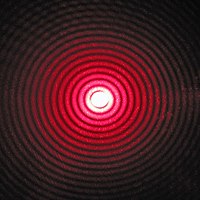物理光学

物理光学(英语:physical optics),又称波动光学(wave optics)是光学的一个分支,研究的是关于干涉、衍射、偏振与其它在几何光学里射线近似不成立的种种现象。假设光波的波长超小于仪器的尺寸,能取波长趋向于零的极限为近似,则可以使用几何光学的方法来解析问题;对于小尺寸仪器,必须假设光波具有有限波长,改使用物理光学的方法来解析问题。[1]:36, 149
在光学通信(optical communication)里,像量子噪音(quantum noise)一类的效应是包括在干涉理论(coherence theory)的研究领域,通常不会包括在物理光学的研究领域。
物理光学建立在惠更斯原理的基础上,可以计算复波前(包括振幅与相位)通过光学系统的模型。这一技术能够利用计算机数值仿真模拟或计算衍射、干涉、偏振、像差等各种复杂光学现象。由于仍然会用到近似,物理光学不能像电磁波理论模型一样地能够全面描述光传播。对于大多数实际问题来说,完整电磁波理论模型需要的计算量太大,在现在的一般计算机硬件条件下并不十分实用,但小尺度的问题可以使用完整波动模型进行计算。
物理光学近似
[编辑]
物理光学也是一种近似的前缀,时常引用于光学、电机工程学、应用物理学。对于这上下文,它属于一种处于忽略波动效应的几何光学与精确波动理论的电磁学之间的中间方法。在“物理光学”这术语里,“物理”两个字的意味着它是比几何光学更偏向物理方面的理论,而不是一门精确波动理论。[2]:11-13
这种近似应用几何光学来估算在曲面位置的场,然后积分这场于整个曲面,这样,可以计算出在任意位置的透射场或散射场。例如,这种近似估算在透镜、镜子、孔径表面的场,然后积分这场于整个表面来计算透射场或散射场。这方法很类似玻恩近似,问题的细节被当作摄动来处理。
在光学里,这是一种标准地估算衍射效应的方法。由于这是一种高频率近似,波长越小,估算结果的准确性越高。
物理光学的标准理论对于估算散射场存在有瑕疵,因此,越偏离镜面方向,准确度越低。[3]2004年,物理学者提出改良理论,能够计算导体的散射场,并且对于相关问题给出精确解。[4]
参阅
[编辑]参考文献
[编辑]- ^ Hecht, Eugene, Optics 4th, United States of America: Addison Wesley, 2002, ISBN 0-8053-8566-5 (英语)
- ^ Pyotr Ya. Ufimtsev. Fundamentals of the Physical Theory of Diffraction. John Wiley & Sons. 9 February 2007. ISBN 978-0-470-10900-7.
- ^ Shijo, T.; Rodriguez, L.; Ando, M. The modified surface-normal vectors in the physical optics. Antennas and Propagation, IEEE Transactions on. Dec 2008, 56 (12): 3714–3722. Bibcode:2008ITAP...56.3714S. doi:10.1109/TAP.2008.2007276.
- ^ Umul, Y. Z. Modified theory of physical optics. Optics Express. October 2004, 12 (20): 4959–4972. Bibcode:2004OExpr..12.4959U. PMID 19484050. doi:10.1364/OPEX.12.004959.
- A double-edge-diffraction Gaussian-series method for efficient physical optics analysis of dual-shaped-reflector antennas. Antennas and Propagation. August 2005: 2597.
- Asvestas, J. S. The physical optics method in electromagnetic scattering. Journal of Mathematical Physics. February 1980, 21 (2): 290–299. Bibcode:1980JMP....21..290A. doi:10.1063/1.524413.
| ||||||||||||||||||||||||||||||||||||||||||||
|
Text is available under the CC BY-SA 4.0 license; additional terms may apply.
Images, videos and audio are available under their respective licenses.
